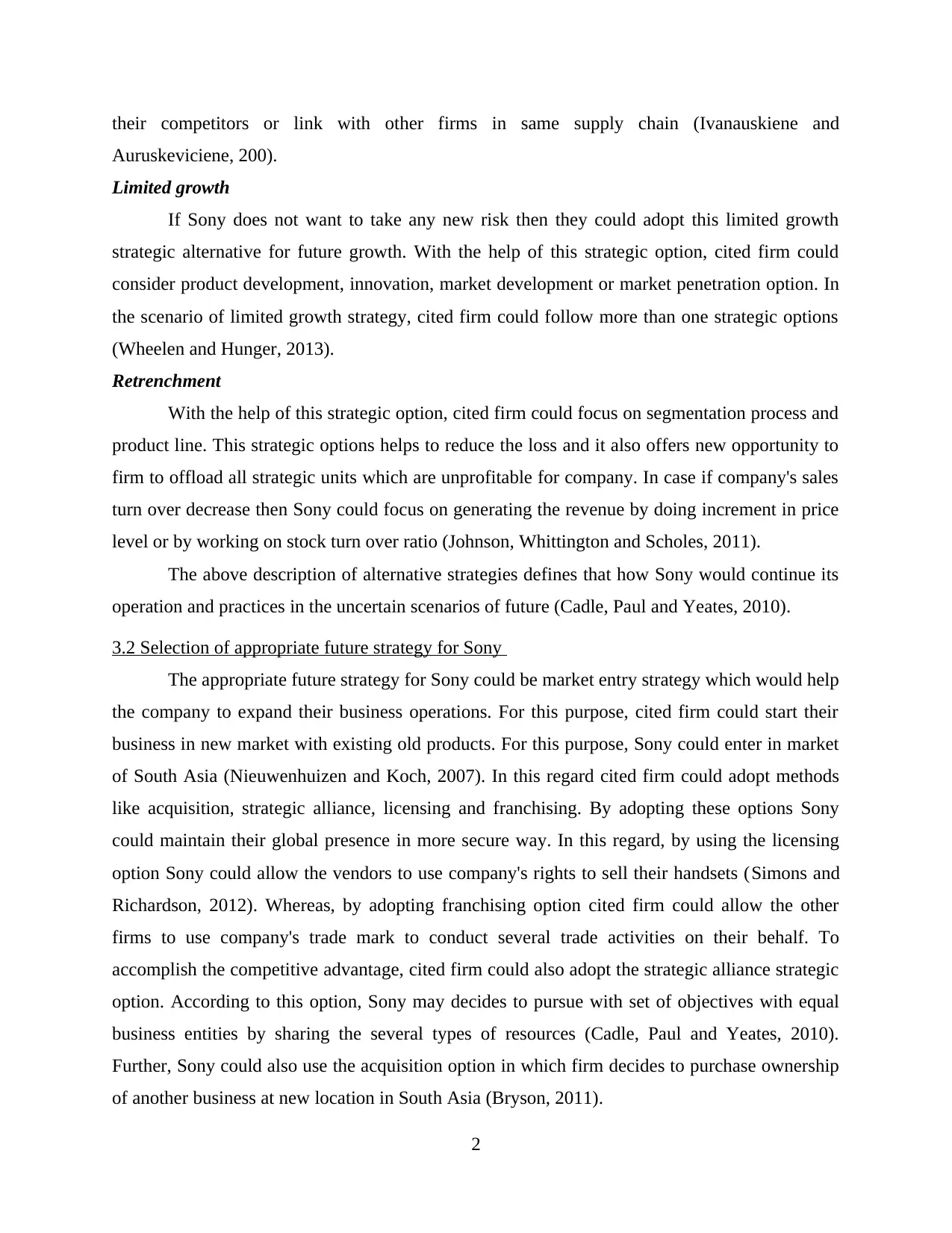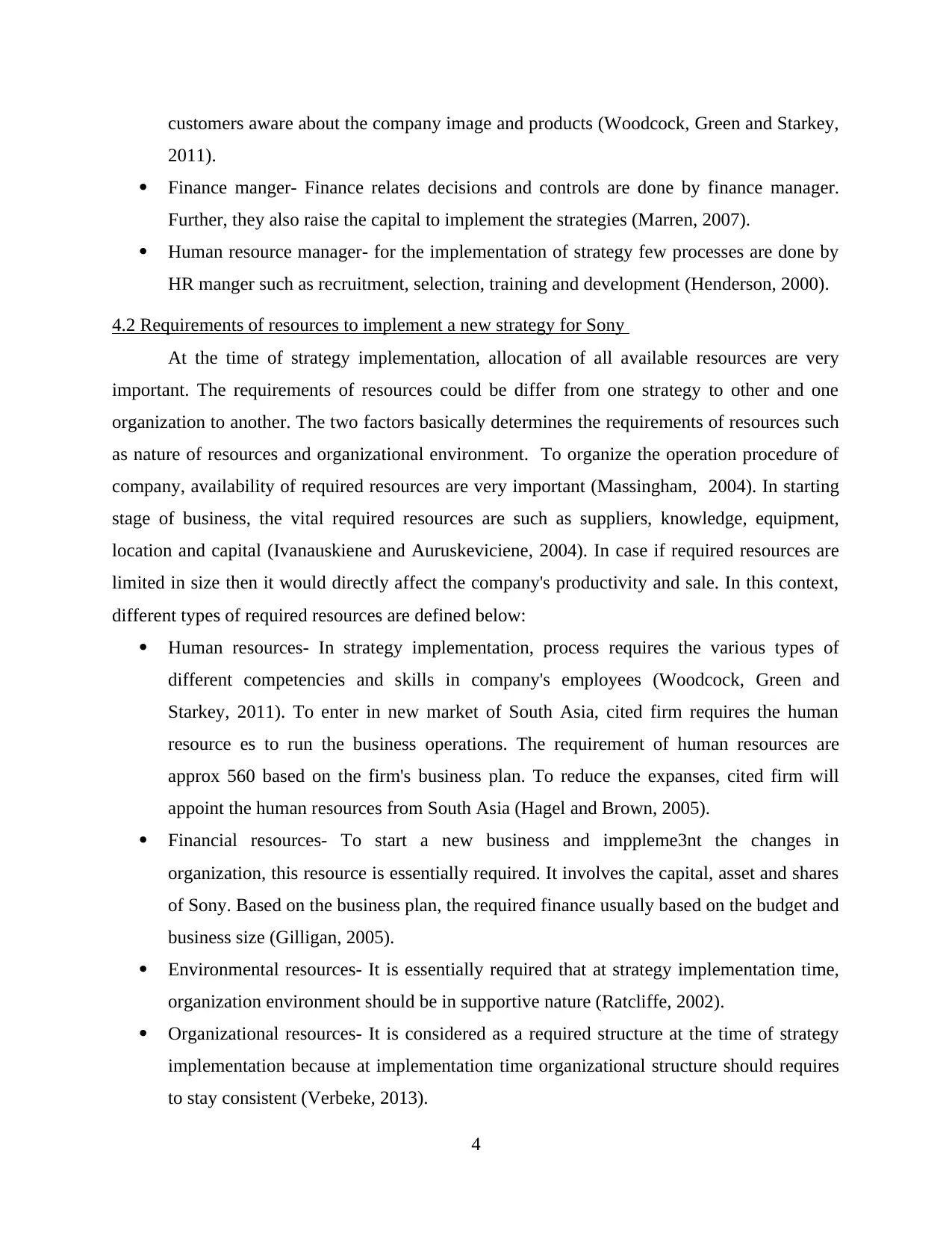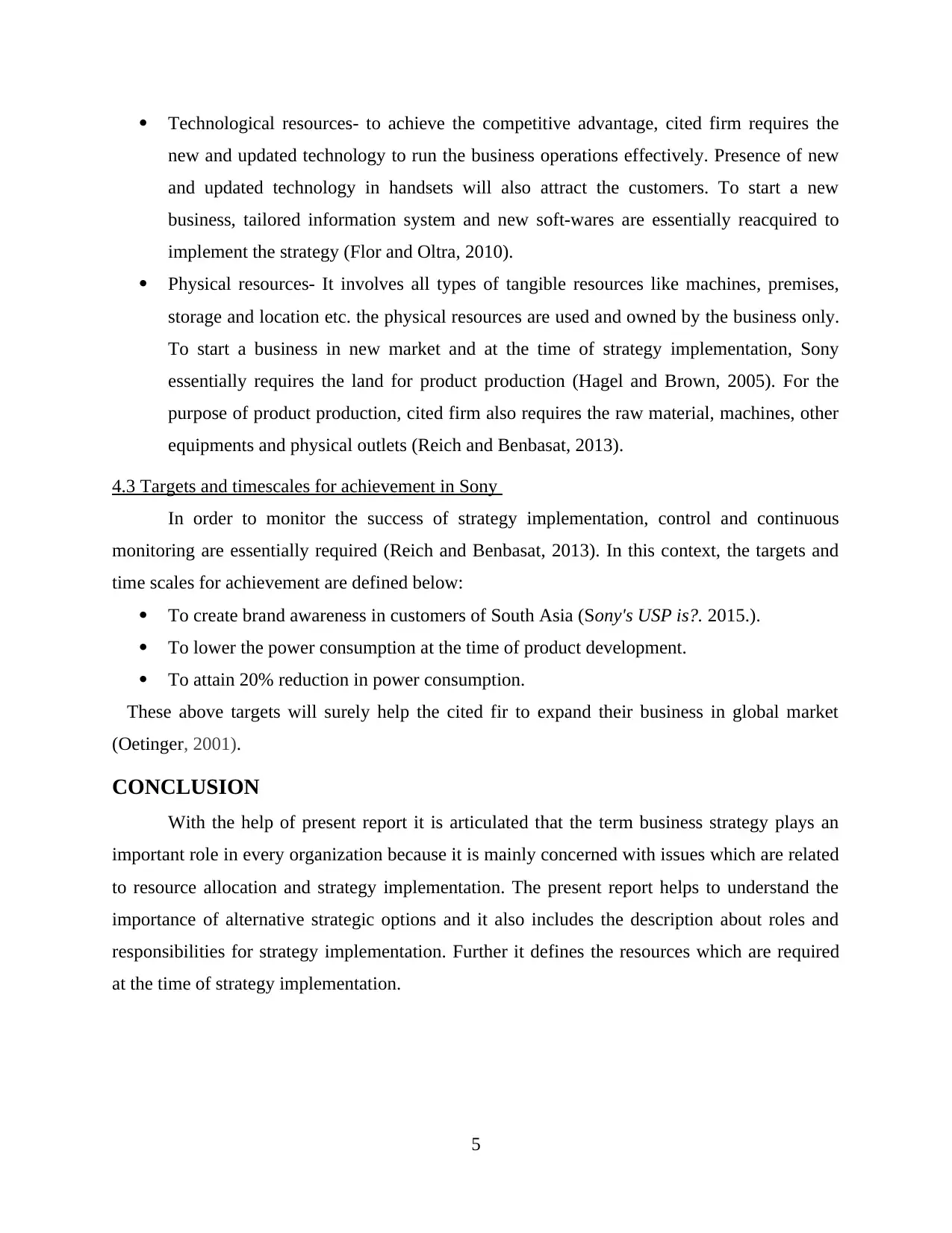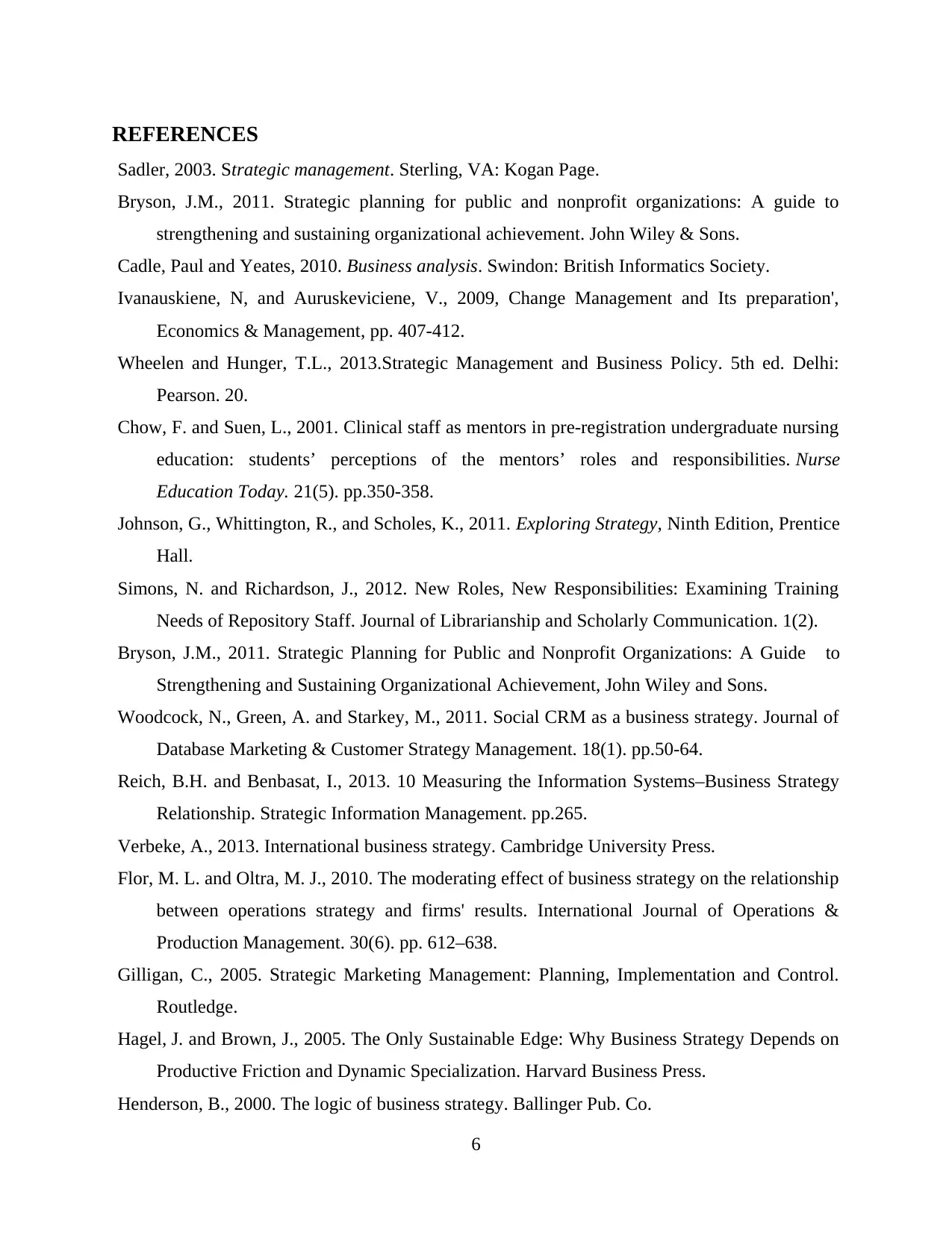Business Strategy Report: Sony's Strategic Analysis and Implementation
VerifiedAdded on 2020/01/07
|9
|2622
|107
Report
AI Summary
This report provides a comprehensive analysis of Sony's business strategy, focusing on strategic alternatives such as market entry, substantive growth, limited growth, and retrenchment. It examines the selection of an appropriate future strategy, specifically the market entry strategy, highlighting methods like franchising, strategic alliances, and acquisitions for expansion into South Asia. The report compares roles and responsibilities for strategy implementation in Sony and Samsung, detailing the responsibilities of various managers like marketing, finance, and HR. It further outlines the resource requirements, including human, financial, environmental, organizational, technological, and physical resources, necessary for implementing a new strategy. Finally, it defines targets and timescales for achievement, emphasizing brand awareness and power consumption reduction. The report concludes by emphasizing the importance of business strategy in resource allocation and implementation, referencing relevant literature to support its findings.

Business Strategy
Paraphrase This Document
Need a fresh take? Get an instant paraphrase of this document with our AI Paraphraser


INTRODUCTION
For every organization, business strategy is very important because it helps to achieve
strategic objectives and goals. It involves management related planning process that helps to
improve the performance of organization (Sadler, 2003). It is basically concerned with the issues
related to resources like product development, sales planning, business planning and raising fund
etc. in this context, business strategy also helps to plan the strategies for product features and
allocation of new business (Woodcock, Green and Starkey, 2011). To understand the concept of
business strategy, Sony Ericsson is considered according to given case study. The present report
will help to understand the options of strategic alternatives like growth and retrenchment etc.
Further, it describes the planning and formulation process of strategy to analyze the need of
several resources. In this report, both selection and implementation of appropriate strategies are
also defined.
TASK 1
In ppt.
TASK 2
In ppt.
TASK 3
3.1 Possible alternative strategies
The strategic alternatives are such as market entry, substantive growth, limited growth
and retrenchment. The Sony could adopt these above options to consider the future strategy.
Market entry
To consider the company's future strategy, Sony could adopt this option. According to
market entry option, firm could enter in new target market by offering the existing product's of
company. In this context, firm could use few methods in new foreign market such as franchising,
joint venture and strategic alliance (Cadle, Paul and Yeates, 2010).
Substantive growth
With the help of this strategic option, Sony could increase their sales and profits. It
provides two options such as integration and diversification. Cited firm could also merge with
1
For every organization, business strategy is very important because it helps to achieve
strategic objectives and goals. It involves management related planning process that helps to
improve the performance of organization (Sadler, 2003). It is basically concerned with the issues
related to resources like product development, sales planning, business planning and raising fund
etc. in this context, business strategy also helps to plan the strategies for product features and
allocation of new business (Woodcock, Green and Starkey, 2011). To understand the concept of
business strategy, Sony Ericsson is considered according to given case study. The present report
will help to understand the options of strategic alternatives like growth and retrenchment etc.
Further, it describes the planning and formulation process of strategy to analyze the need of
several resources. In this report, both selection and implementation of appropriate strategies are
also defined.
TASK 1
In ppt.
TASK 2
In ppt.
TASK 3
3.1 Possible alternative strategies
The strategic alternatives are such as market entry, substantive growth, limited growth
and retrenchment. The Sony could adopt these above options to consider the future strategy.
Market entry
To consider the company's future strategy, Sony could adopt this option. According to
market entry option, firm could enter in new target market by offering the existing product's of
company. In this context, firm could use few methods in new foreign market such as franchising,
joint venture and strategic alliance (Cadle, Paul and Yeates, 2010).
Substantive growth
With the help of this strategic option, Sony could increase their sales and profits. It
provides two options such as integration and diversification. Cited firm could also merge with
1
⊘ This is a preview!⊘
Do you want full access?
Subscribe today to unlock all pages.

Trusted by 1+ million students worldwide

their competitors or link with other firms in same supply chain (Ivanauskiene and
Auruskeviciene, 200).
Limited growth
If Sony does not want to take any new risk then they could adopt this limited growth
strategic alternative for future growth. With the help of this strategic option, cited firm could
consider product development, innovation, market development or market penetration option. In
the scenario of limited growth strategy, cited firm could follow more than one strategic options
(Wheelen and Hunger, 2013).
Retrenchment
With the help of this strategic option, cited firm could focus on segmentation process and
product line. This strategic options helps to reduce the loss and it also offers new opportunity to
firm to offload all strategic units which are unprofitable for company. In case if company's sales
turn over decrease then Sony could focus on generating the revenue by doing increment in price
level or by working on stock turn over ratio (Johnson, Whittington and Scholes, 2011).
The above description of alternative strategies defines that how Sony would continue its
operation and practices in the uncertain scenarios of future (Cadle, Paul and Yeates, 2010).
3.2 Selection of appropriate future strategy for Sony
The appropriate future strategy for Sony could be market entry strategy which would help
the company to expand their business operations. For this purpose, cited firm could start their
business in new market with existing old products. For this purpose, Sony could enter in market
of South Asia (Nieuwenhuizen and Koch, 2007). In this regard cited firm could adopt methods
like acquisition, strategic alliance, licensing and franchising. By adopting these options Sony
could maintain their global presence in more secure way. In this regard, by using the licensing
option Sony could allow the vendors to use company's rights to sell their handsets (Simons and
Richardson, 2012). Whereas, by adopting franchising option cited firm could allow the other
firms to use company's trade mark to conduct several trade activities on their behalf. To
accomplish the competitive advantage, cited firm could also adopt the strategic alliance strategic
option. According to this option, Sony may decides to pursue with set of objectives with equal
business entities by sharing the several types of resources (Cadle, Paul and Yeates, 2010).
Further, Sony could also use the acquisition option in which firm decides to purchase ownership
of another business at new location in South Asia (Bryson, 2011).
2
Auruskeviciene, 200).
Limited growth
If Sony does not want to take any new risk then they could adopt this limited growth
strategic alternative for future growth. With the help of this strategic option, cited firm could
consider product development, innovation, market development or market penetration option. In
the scenario of limited growth strategy, cited firm could follow more than one strategic options
(Wheelen and Hunger, 2013).
Retrenchment
With the help of this strategic option, cited firm could focus on segmentation process and
product line. This strategic options helps to reduce the loss and it also offers new opportunity to
firm to offload all strategic units which are unprofitable for company. In case if company's sales
turn over decrease then Sony could focus on generating the revenue by doing increment in price
level or by working on stock turn over ratio (Johnson, Whittington and Scholes, 2011).
The above description of alternative strategies defines that how Sony would continue its
operation and practices in the uncertain scenarios of future (Cadle, Paul and Yeates, 2010).
3.2 Selection of appropriate future strategy for Sony
The appropriate future strategy for Sony could be market entry strategy which would help
the company to expand their business operations. For this purpose, cited firm could start their
business in new market with existing old products. For this purpose, Sony could enter in market
of South Asia (Nieuwenhuizen and Koch, 2007). In this regard cited firm could adopt methods
like acquisition, strategic alliance, licensing and franchising. By adopting these options Sony
could maintain their global presence in more secure way. In this regard, by using the licensing
option Sony could allow the vendors to use company's rights to sell their handsets (Simons and
Richardson, 2012). Whereas, by adopting franchising option cited firm could allow the other
firms to use company's trade mark to conduct several trade activities on their behalf. To
accomplish the competitive advantage, cited firm could also adopt the strategic alliance strategic
option. According to this option, Sony may decides to pursue with set of objectives with equal
business entities by sharing the several types of resources (Cadle, Paul and Yeates, 2010).
Further, Sony could also use the acquisition option in which firm decides to purchase ownership
of another business at new location in South Asia (Bryson, 2011).
2
Paraphrase This Document
Need a fresh take? Get an instant paraphrase of this document with our AI Paraphraser

TASK 4
4.1 Comparison of roles and responsibilities for strategy implementation in Sony and Samsung
For the success of strategy implementation, strong managerial leadership are essentially
requires in organization. It is important for chief executive offices to create and implement the
new changes in organization. In Samsung, top management level plays a crucial role in strategy
implementation process (Poulfelt, 2009). In this context, they set the goals of strategy and ways
of implementation in organization. In organization, middle level management basically carries
strategic view and also monitors the management of lower level. The lower level management
sets the operations and activities of organization. In strategy implementation, they help to
achieve the strategic goals of organization and follows the instructions of middle level
management (Ivanauskiene and Auruskeviciene, 2004).
On the other side, Sony introduces mainly three types of roles for strategy
implementation in company. In this context, roles are such as envisioning future strategy,
alignment to deliver strategy and embodying change in organization. The role of envisioning
future strategy involves the clear communication method with all stakeholders of organization
(Bryson, 2011). Further, in next role it is expected from all employees to be committed with
goals of strategy. It is important that employees should be motivated to follow the strategy in
effective manner. The employee should be empowered to present the change. In this regard the
last role is about embodying the change (Organisation data. 2016). This role describes that
implementation of strategy also includes the changes in organization. In the strategic change
process, leaders or managers plays an important role in this. At the time of strategy
implementation few ares are considered such as sense making of strategy, adjustments related to
strategic response and reinterpretation (Chow and Suen, 2001).
To expand the global presence in foreign market, cited company has to implement new
business strategy. On this basis, firm has to give the charges to various employees. For this
purpose, managers of different departments have the major roles and responsibilities related to
strategy implementation (Cadle, Paul and Yeates, 2010). The roles and responsibilities of
different managers are described below which are as follows:
Marketing manager- To promote the products in new market of South Asia, Sony has to
make the plans for this purpose. Marketing managers have the motive to make the
3
4.1 Comparison of roles and responsibilities for strategy implementation in Sony and Samsung
For the success of strategy implementation, strong managerial leadership are essentially
requires in organization. It is important for chief executive offices to create and implement the
new changes in organization. In Samsung, top management level plays a crucial role in strategy
implementation process (Poulfelt, 2009). In this context, they set the goals of strategy and ways
of implementation in organization. In organization, middle level management basically carries
strategic view and also monitors the management of lower level. The lower level management
sets the operations and activities of organization. In strategy implementation, they help to
achieve the strategic goals of organization and follows the instructions of middle level
management (Ivanauskiene and Auruskeviciene, 2004).
On the other side, Sony introduces mainly three types of roles for strategy
implementation in company. In this context, roles are such as envisioning future strategy,
alignment to deliver strategy and embodying change in organization. The role of envisioning
future strategy involves the clear communication method with all stakeholders of organization
(Bryson, 2011). Further, in next role it is expected from all employees to be committed with
goals of strategy. It is important that employees should be motivated to follow the strategy in
effective manner. The employee should be empowered to present the change. In this regard the
last role is about embodying the change (Organisation data. 2016). This role describes that
implementation of strategy also includes the changes in organization. In the strategic change
process, leaders or managers plays an important role in this. At the time of strategy
implementation few ares are considered such as sense making of strategy, adjustments related to
strategic response and reinterpretation (Chow and Suen, 2001).
To expand the global presence in foreign market, cited company has to implement new
business strategy. On this basis, firm has to give the charges to various employees. For this
purpose, managers of different departments have the major roles and responsibilities related to
strategy implementation (Cadle, Paul and Yeates, 2010). The roles and responsibilities of
different managers are described below which are as follows:
Marketing manager- To promote the products in new market of South Asia, Sony has to
make the plans for this purpose. Marketing managers have the motive to make the
3

customers aware about the company image and products (Woodcock, Green and Starkey,
2011).
Finance manger- Finance relates decisions and controls are done by finance manager.
Further, they also raise the capital to implement the strategies (Marren, 2007).
Human resource manager- for the implementation of strategy few processes are done by
HR manger such as recruitment, selection, training and development (Henderson, 2000).
4.2 Requirements of resources to implement a new strategy for Sony
At the time of strategy implementation, allocation of all available resources are very
important. The requirements of resources could be differ from one strategy to other and one
organization to another. The two factors basically determines the requirements of resources such
as nature of resources and organizational environment. To organize the operation procedure of
company, availability of required resources are very important (Massingham, 2004). In starting
stage of business, the vital required resources are such as suppliers, knowledge, equipment,
location and capital (Ivanauskiene and Auruskeviciene, 2004). In case if required resources are
limited in size then it would directly affect the company's productivity and sale. In this context,
different types of required resources are defined below:
Human resources- In strategy implementation, process requires the various types of
different competencies and skills in company's employees (Woodcock, Green and
Starkey, 2011). To enter in new market of South Asia, cited firm requires the human
resource es to run the business operations. The requirement of human resources are
approx 560 based on the firm's business plan. To reduce the expanses, cited firm will
appoint the human resources from South Asia (Hagel and Brown, 2005).
Financial resources- To start a new business and imppleme3nt the changes in
organization, this resource is essentially required. It involves the capital, asset and shares
of Sony. Based on the business plan, the required finance usually based on the budget and
business size (Gilligan, 2005).
Environmental resources- It is essentially required that at strategy implementation time,
organization environment should be in supportive nature (Ratcliffe, 2002).
Organizational resources- It is considered as a required structure at the time of strategy
implementation because at implementation time organizational structure should requires
to stay consistent (Verbeke, 2013).
4
2011).
Finance manger- Finance relates decisions and controls are done by finance manager.
Further, they also raise the capital to implement the strategies (Marren, 2007).
Human resource manager- for the implementation of strategy few processes are done by
HR manger such as recruitment, selection, training and development (Henderson, 2000).
4.2 Requirements of resources to implement a new strategy for Sony
At the time of strategy implementation, allocation of all available resources are very
important. The requirements of resources could be differ from one strategy to other and one
organization to another. The two factors basically determines the requirements of resources such
as nature of resources and organizational environment. To organize the operation procedure of
company, availability of required resources are very important (Massingham, 2004). In starting
stage of business, the vital required resources are such as suppliers, knowledge, equipment,
location and capital (Ivanauskiene and Auruskeviciene, 2004). In case if required resources are
limited in size then it would directly affect the company's productivity and sale. In this context,
different types of required resources are defined below:
Human resources- In strategy implementation, process requires the various types of
different competencies and skills in company's employees (Woodcock, Green and
Starkey, 2011). To enter in new market of South Asia, cited firm requires the human
resource es to run the business operations. The requirement of human resources are
approx 560 based on the firm's business plan. To reduce the expanses, cited firm will
appoint the human resources from South Asia (Hagel and Brown, 2005).
Financial resources- To start a new business and imppleme3nt the changes in
organization, this resource is essentially required. It involves the capital, asset and shares
of Sony. Based on the business plan, the required finance usually based on the budget and
business size (Gilligan, 2005).
Environmental resources- It is essentially required that at strategy implementation time,
organization environment should be in supportive nature (Ratcliffe, 2002).
Organizational resources- It is considered as a required structure at the time of strategy
implementation because at implementation time organizational structure should requires
to stay consistent (Verbeke, 2013).
4
⊘ This is a preview!⊘
Do you want full access?
Subscribe today to unlock all pages.

Trusted by 1+ million students worldwide

Technological resources- to achieve the competitive advantage, cited firm requires the
new and updated technology to run the business operations effectively. Presence of new
and updated technology in handsets will also attract the customers. To start a new
business, tailored information system and new soft-wares are essentially reacquired to
implement the strategy (Flor and Oltra, 2010).
Physical resources- It involves all types of tangible resources like machines, premises,
storage and location etc. the physical resources are used and owned by the business only.
To start a business in new market and at the time of strategy implementation, Sony
essentially requires the land for product production (Hagel and Brown, 2005). For the
purpose of product production, cited firm also requires the raw material, machines, other
equipments and physical outlets (Reich and Benbasat, 2013).
4.3 Targets and timescales for achievement in Sony
In order to monitor the success of strategy implementation, control and continuous
monitoring are essentially required (Reich and Benbasat, 2013). In this context, the targets and
time scales for achievement are defined below:
To create brand awareness in customers of South Asia (Sony's USP is?. 2015.).
To lower the power consumption at the time of product development.
To attain 20% reduction in power consumption.
These above targets will surely help the cited fir to expand their business in global market
(Oetinger, 2001).
CONCLUSION
With the help of present report it is articulated that the term business strategy plays an
important role in every organization because it is mainly concerned with issues which are related
to resource allocation and strategy implementation. The present report helps to understand the
importance of alternative strategic options and it also includes the description about roles and
responsibilities for strategy implementation. Further it defines the resources which are required
at the time of strategy implementation.
5
new and updated technology to run the business operations effectively. Presence of new
and updated technology in handsets will also attract the customers. To start a new
business, tailored information system and new soft-wares are essentially reacquired to
implement the strategy (Flor and Oltra, 2010).
Physical resources- It involves all types of tangible resources like machines, premises,
storage and location etc. the physical resources are used and owned by the business only.
To start a business in new market and at the time of strategy implementation, Sony
essentially requires the land for product production (Hagel and Brown, 2005). For the
purpose of product production, cited firm also requires the raw material, machines, other
equipments and physical outlets (Reich and Benbasat, 2013).
4.3 Targets and timescales for achievement in Sony
In order to monitor the success of strategy implementation, control and continuous
monitoring are essentially required (Reich and Benbasat, 2013). In this context, the targets and
time scales for achievement are defined below:
To create brand awareness in customers of South Asia (Sony's USP is?. 2015.).
To lower the power consumption at the time of product development.
To attain 20% reduction in power consumption.
These above targets will surely help the cited fir to expand their business in global market
(Oetinger, 2001).
CONCLUSION
With the help of present report it is articulated that the term business strategy plays an
important role in every organization because it is mainly concerned with issues which are related
to resource allocation and strategy implementation. The present report helps to understand the
importance of alternative strategic options and it also includes the description about roles and
responsibilities for strategy implementation. Further it defines the resources which are required
at the time of strategy implementation.
5
Paraphrase This Document
Need a fresh take? Get an instant paraphrase of this document with our AI Paraphraser

REFERENCES
Sadler, 2003. Strategic management. Sterling, VA: Kogan Page.
Bryson, J.M., 2011. Strategic planning for public and nonprofit organizations: A guide to
strengthening and sustaining organizational achievement. John Wiley & Sons.
Cadle, Paul and Yeates, 2010. Business analysis. Swindon: British Informatics Society.
Ivanauskiene, N, and Auruskeviciene, V., 2009, Change Management and Its preparation',
Economics & Management, pp. 407-412.
Wheelen and Hunger, T.L., 2013.Strategic Management and Business Policy. 5th ed. Delhi:
Pearson. 20.
Chow, F. and Suen, L., 2001. Clinical staff as mentors in pre-registration undergraduate nursing
education: students’ perceptions of the mentors’ roles and responsibilities. Nurse
Education Today. 21(5). pp.350-358.
Johnson, G., Whittington, R., and Scholes, K., 2011. Exploring Strategy, Ninth Edition, Prentice
Hall.
Simons, N. and Richardson, J., 2012. New Roles, New Responsibilities: Examining Training
Needs of Repository Staff. Journal of Librarianship and Scholarly Communication. 1(2).
Bryson, J.M., 2011. Strategic Planning for Public and Nonprofit Organizations: A Guide to
Strengthening and Sustaining Organizational Achievement, John Wiley and Sons.
Woodcock, N., Green, A. and Starkey, M., 2011. Social CRM as a business strategy. Journal of
Database Marketing & Customer Strategy Management. 18(1). pp.50-64.
Reich, B.H. and Benbasat, I., 2013. 10 Measuring the Information Systems–Business Strategy
Relationship. Strategic Information Management. pp.265.
Verbeke, A., 2013. International business strategy. Cambridge University Press.
Flor, M. L. and Oltra, M. J., 2010. The moderating effect of business strategy on the relationship
between operations strategy and firms' results. International Journal of Operations &
Production Management. 30(6). pp. 612–638.
Gilligan, C., 2005. Strategic Marketing Management: Planning, Implementation and Control.
Routledge.
Hagel, J. and Brown, J., 2005. The Only Sustainable Edge: Why Business Strategy Depends on
Productive Friction and Dynamic Specialization. Harvard Business Press.
Henderson, B., 2000. The logic of business strategy. Ballinger Pub. Co.
6
Sadler, 2003. Strategic management. Sterling, VA: Kogan Page.
Bryson, J.M., 2011. Strategic planning for public and nonprofit organizations: A guide to
strengthening and sustaining organizational achievement. John Wiley & Sons.
Cadle, Paul and Yeates, 2010. Business analysis. Swindon: British Informatics Society.
Ivanauskiene, N, and Auruskeviciene, V., 2009, Change Management and Its preparation',
Economics & Management, pp. 407-412.
Wheelen and Hunger, T.L., 2013.Strategic Management and Business Policy. 5th ed. Delhi:
Pearson. 20.
Chow, F. and Suen, L., 2001. Clinical staff as mentors in pre-registration undergraduate nursing
education: students’ perceptions of the mentors’ roles and responsibilities. Nurse
Education Today. 21(5). pp.350-358.
Johnson, G., Whittington, R., and Scholes, K., 2011. Exploring Strategy, Ninth Edition, Prentice
Hall.
Simons, N. and Richardson, J., 2012. New Roles, New Responsibilities: Examining Training
Needs of Repository Staff. Journal of Librarianship and Scholarly Communication. 1(2).
Bryson, J.M., 2011. Strategic Planning for Public and Nonprofit Organizations: A Guide to
Strengthening and Sustaining Organizational Achievement, John Wiley and Sons.
Woodcock, N., Green, A. and Starkey, M., 2011. Social CRM as a business strategy. Journal of
Database Marketing & Customer Strategy Management. 18(1). pp.50-64.
Reich, B.H. and Benbasat, I., 2013. 10 Measuring the Information Systems–Business Strategy
Relationship. Strategic Information Management. pp.265.
Verbeke, A., 2013. International business strategy. Cambridge University Press.
Flor, M. L. and Oltra, M. J., 2010. The moderating effect of business strategy on the relationship
between operations strategy and firms' results. International Journal of Operations &
Production Management. 30(6). pp. 612–638.
Gilligan, C., 2005. Strategic Marketing Management: Planning, Implementation and Control.
Routledge.
Hagel, J. and Brown, J., 2005. The Only Sustainable Edge: Why Business Strategy Depends on
Productive Friction and Dynamic Specialization. Harvard Business Press.
Henderson, B., 2000. The logic of business strategy. Ballinger Pub. Co.
6

Marren, M., 2007. High-functioning business strategy. Journal of Business Strategy. 28(6).
pp.37–39.
Massingham, P., 2004. Linking business level strategy with activities and knowledge resources.
Journal of Knowledge Management. 8(6). pp.50–62.
Nieuwenhuizen, P. and Koch, R., 2007. A good business strategy need not be difficult: How
Simply Strategy can improve your business. Strategic Direction. 23(3). pp.3–5.
Oetinger, B., 2001. THE RENAISSANCE STRATEGIST. Journal of Business Strategy. 22(6).
pp.38 – 42.
Poulfelt, F., 2009. Discount Business Strategy: How the New Market Leaders are Redefining
Business Strategy. John Wiley & Sons.
Ratcliffe, J., 2002. Scenario planning: strategic interviews and conversations. Foresight. 4(1).
pp.19 – 30.
Online
Sony's USP is?. 2015. [Online]. Available through:
<http://douglasgoh.blogspot.in/2011/09/sonys-usp-is.html>. [Accessed on 16th December 2015].
Organisation data. 2016. [Online]. Available Through
<http://www.sony.net/SonyInfo/CorporateInfo/Data/organization.html>. [Accessed on
22ndFebruary 2].16]
7
pp.37–39.
Massingham, P., 2004. Linking business level strategy with activities and knowledge resources.
Journal of Knowledge Management. 8(6). pp.50–62.
Nieuwenhuizen, P. and Koch, R., 2007. A good business strategy need not be difficult: How
Simply Strategy can improve your business. Strategic Direction. 23(3). pp.3–5.
Oetinger, B., 2001. THE RENAISSANCE STRATEGIST. Journal of Business Strategy. 22(6).
pp.38 – 42.
Poulfelt, F., 2009. Discount Business Strategy: How the New Market Leaders are Redefining
Business Strategy. John Wiley & Sons.
Ratcliffe, J., 2002. Scenario planning: strategic interviews and conversations. Foresight. 4(1).
pp.19 – 30.
Online
Sony's USP is?. 2015. [Online]. Available through:
<http://douglasgoh.blogspot.in/2011/09/sonys-usp-is.html>. [Accessed on 16th December 2015].
Organisation data. 2016. [Online]. Available Through
<http://www.sony.net/SonyInfo/CorporateInfo/Data/organization.html>. [Accessed on
22ndFebruary 2].16]
7
⊘ This is a preview!⊘
Do you want full access?
Subscribe today to unlock all pages.

Trusted by 1+ million students worldwide
1 out of 9
Related Documents
Your All-in-One AI-Powered Toolkit for Academic Success.
+13062052269
info@desklib.com
Available 24*7 on WhatsApp / Email
![[object Object]](/_next/static/media/star-bottom.7253800d.svg)
Unlock your academic potential
Copyright © 2020–2025 A2Z Services. All Rights Reserved. Developed and managed by ZUCOL.





